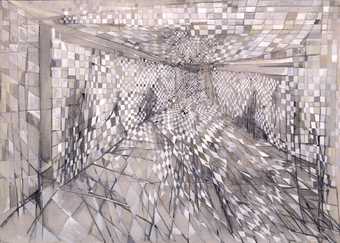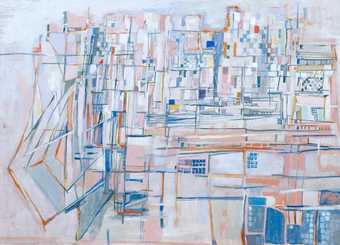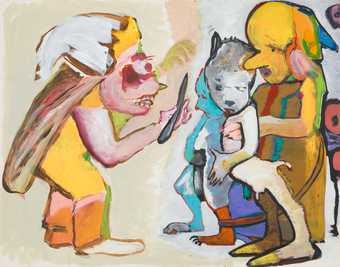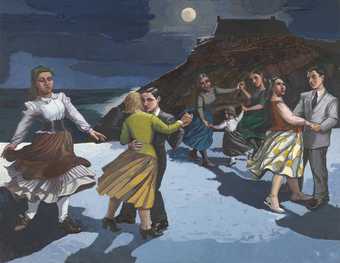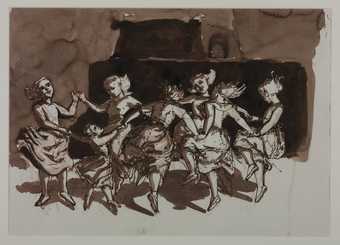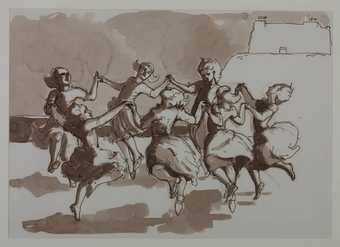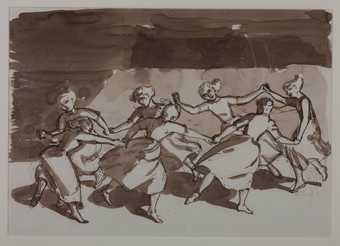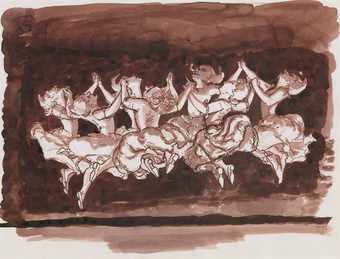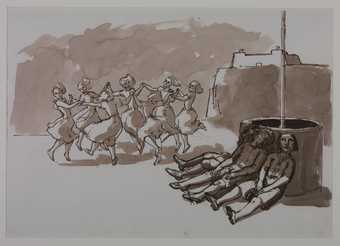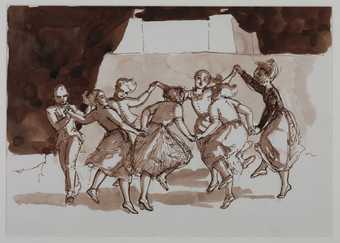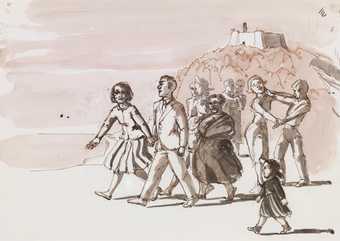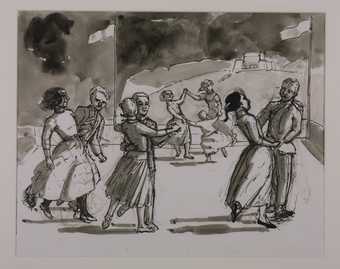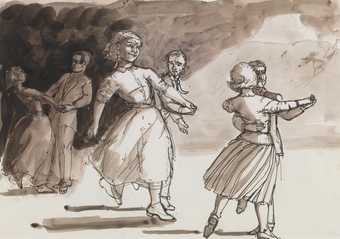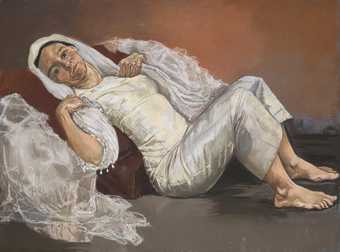
In Tate Britain
- Artist
- Paula Rego 1935 – 2022
- Medium
- Acrylic paint, oil pastel, charcoal, graphite, resin, ink, paper and aluminium foil on canvas
- Dimensions
- Frame: 1539 × 1843 × 45 mm
- Collection
- Tate
- Acquisition
- Purchased with assistance from Evelyn, Lady Downshire's Fund 2000
- Reference
- T07778
Summary
This is a large painting depicting a group of surreal, brightly-coloured figures against a rich red and orange background. The figures are a mixture of human and animal forms combined with convoluted intestinal imagery and abstracted machine-like shapes reminiscent of the forms Marcel Duchamp (1887-1968) painted in his Brides and Nudes series of paintings in 1912. The title of Rego's painting is derived from a group of firemen she saw in Alijo, a small town in northern Portugal, while on holiday there over Christmas and new year 1965-6. The winter was the coldest on record; it snowed and the hotel Rego was staying in with her husband, the artist Victor Willing (1928-88), and her parents had no heating. Rego's father was terminally ill with cancer (he died six months later), her husband was in a bad mood the whole time and Rego said she felt 'a sense of the end of the world' (in unpublished conversation with Judith Collins, 2000). Leaving her mother in her room doing her hair, she wandered around the town and was struck by the poverty of its inhabitants. She saw the firemen outside a tavern huddled together because of the cold. They had bare feet and wore traditional Portuguese coats padded with straw. Their faces were black with soot. Rego has described the painting as a homage to their role in Portuguese society as unpaid volunteers. No figure in the painting is a representation of any particular fireman, but rather an expression of her feelings around that time.
Rego has said: 'I can only understand ideas in terms of human relationships - I don't understand political abstractions. People as characters are far more real to me.' (Quoted in McEwen p.76.) She uses her personal narrative and experiences to describe feelings around moral, social and political issues. Rego and Willing lived in Portugal between 1957 and 1962. In 1960 during a brief visit to London for the birth of her second child Victoria, Rego saw an exhibition of work by the French painter and father of 'Art Brut', Jean Dubuffet (1901-85), and was immediately inspired. The discovery of Dubuffet's work helped Rego to reconnect with the intuitive spirit of her childhood, giving her the confidence to allow her imagination free reign in large, childlike scribbles. The accompanying release of energy generated by this process resulted in bright colours communicating a vivid, raw energy. Shortly afterwards Rego began a new body of work, completing a painting each day and often incorporating collaged elements. Initially these were taken from magazines, but when she could not find what she wanted she drew and painted the image on paper and then cut it out. The Firemen of Alijo was made using collaged fragments onto which Rego had previously drawn in charcoal and pastel and painted with gouache and inks. On the left of the painting is a bare-footed man with a badger's head. To the right of him a human-type body topped by a profiled head emerges from an animal base derived from a reproduction of a seal. Balancing on the seal's head is a bird-like figure. The area above the ground, from which it is separated by a narrow green horizontal line, is filled with figures the artist sees as fighting angels. To create these Rego looked at books on medieval art since she wanted to reflect the medieval core of the town of Alijo. She has said: 'I get inspiration from things that have nothing to do with painting: caricature, items from newspapers, sights in the street, proverbs, nursery-rhymes, children's games and songs, nightmares, desires, terrors.' (Quoted in McEwen, p.72.) As she once stated, she paints 'to give terror a face' (quoted in McEwen, p.72).
Further reading:
John McEwen, Paula Rego, London 1997, reproduced (colour) p.81, pl.72
Judith Collins, Ruth Rosengarten, Victor Willing, Paula Rego, exhibition catalogue, Tate Gallery Liverpool 1997
Elizabeth Manchester
January 2002
Does this text contain inaccurate information or language that you feel we should improve or change? We would like to hear from you.
Explore
- abstraction(8,615)
-
- from recognisable sources(3,634)
-
- figure(2,270)
- entrails(9)
- cities, towns, villages (non-UK)(13,323)
-
- Alijo(1)
- Portugal(64)
- universal religious imagery(859)
-
- angel(267)
- public service(872)
-
- fireman(15)
You might like
-
Maria Helena Vieira da Silva The Corridor
1950 -
Maria Helena Vieira da Silva Paris
1951 -
Paula Rego Nanny, Small Bears and Bogeyman
1982 -
Paula Rego The Dance
1988 -
Paula Rego Drawing for ‘The Dance’
1988 -
Paula Rego Drawing for ‘The Dance’
1988 -
Paula Rego Drawing for ‘The Dance’
1988 -
Paula Rego Drawing for ‘The Dance’
1988 -
Paula Rego Drawing for ‘The Dance’
1988 -
Paula Rego Drawing for ‘The Dance’
1988 -
Paula Rego Drawing for ‘The Dance’
1988 -
Paula Rego Drawing for ‘The Dance’
1988 -
Paula Rego Drawing for ‘The Dance’
1988 -
Paula Rego Drawing for ‘The Dance’
1988 -
Paula Rego Bride
1994

